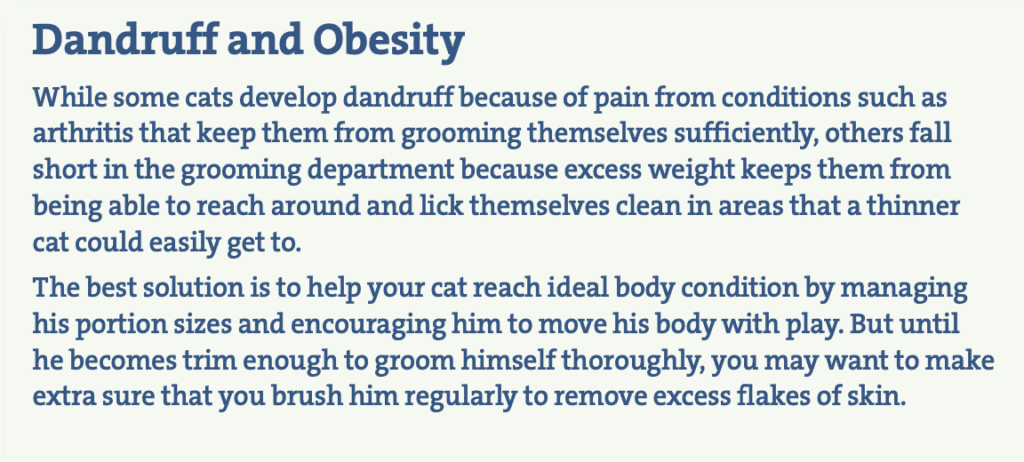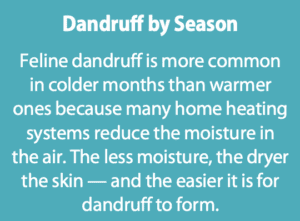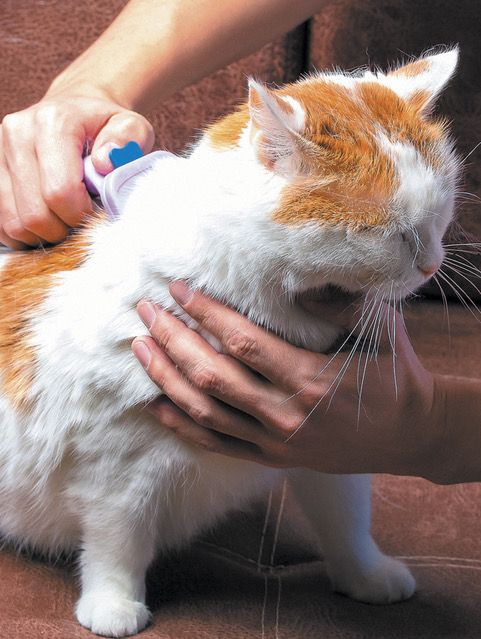Your cat regularly grooms herself, and you brush her, too, but no matter what, her coat always has a fair amount of dandruff.
It’s not just a cosmetic issue. A cat with a lot of dandruff may feel uncomfortably itchy — but not show it. While dogs tend to scratch and lick themselves in a very public way to tend to an itch, many cats scratch or over-
groom in privacy.
Dandruff often results from a health issue. Here are some possible causes of dandruff, which is an excessive shedding of dead skin cells.
Inadequate diet. Feline skin needs essential trace minerals and distinct amounts of high-quality protein. It also requires the right essential fatty acids in the right proportions. These include an omega-6 fatty acid called linoleic acid, which is found in vegetable oils, chicken fat, and meat. The cat food you buy will have the minimum concentration of fatty acids to meet the standards set by the Association of American Feed Control Officials. But in the case of excessive dandruff flakes, your veterinarian might recommend switching to a food with more of the necessary fat, or supplements in the form of tiny amounts of oil — something on the order of an eighth of a teaspoon of oil a day.
Allergy. Sometimes a cat with dandruff is allergic to a particular food or something in the environment. Such a cat may have skin that is inflamed, itchy, and dry — the perfect environment for dandruff development. You and the vet will need to work backwards to figure out the allergy trigger.
Parasites. Dandruff can be caused by such insects as fleas, lice, and mites. The vet may look at skin cells under a microscope to check for parasites and may also order various tests. Treating an infestation once it has been properly identified should clear up the white flakes. Afterwards, year-round prevention of parasites taking up residence on your cat is recommended.

Skin infection. A skin infection in a cat can come from bacteria or a fungus. One such fungus is ringworm. It can lead not only to dandruff but also scabs that are circular in shape. The doctor will identify the underlying problem causing the infection and will know what medicine to prescribe based on the type of invader he identifies.
Seborrhea. Although not common, when a cat comes down with seborrhea, her sebaceous glands create an imbalance in protective skin oils. That leads to increased cell shedding, or dandruff. Treatments include special shampoos and topicals, corticosteroids, supplements of omega-3 fatty acids, and cyclosporine. An antibiotic may also be necessary if a secondary infection has developed.
Systemic diseases. These include diabetes, kidney disease, liver disease, and 

Stress. Sometimes, in periods of stress a cat can shed a fair amount of dandruff. A typical example: a visit to the veterinarian. The shedding of skin flakes subsides once the cat returns home.




